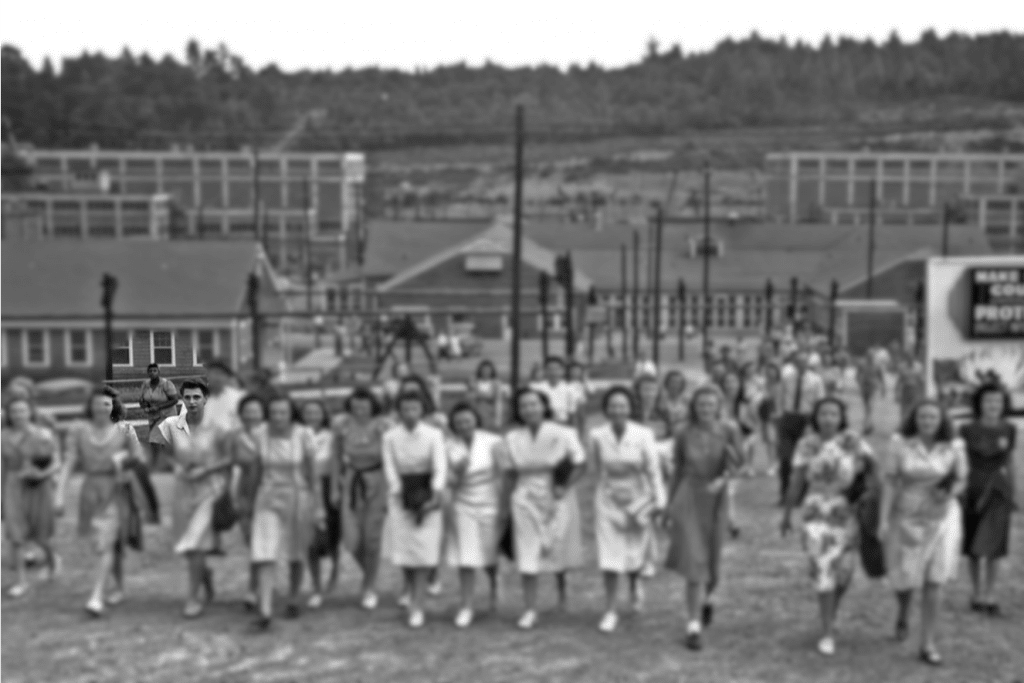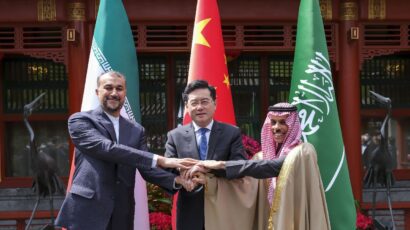A call for antiracist action and accountability in the US nuclear community
By Katlyn M. Turner, Lauren J. Borja, Denia Djokić, Madicken Munk, Aditi Verma | August 24, 2020

Authors’ note: This piece was reviewed and edited by Professor Gabrielle Hecht (Stanford University), Professor Susan Silbey (MIT), and several contributors who prefer to remain anonymous, to whom the authors are deeply grateful.
The recent depraved killings of George Floyd, Breonna Taylor, Ahmaud Arbery, and Rayshard Brooks ignited widespread protests across the United States, representing a renewed outrage at centuries of white supremacy, colonialism, and state-sanctioned oppression of and brutality against Black people. While not new, this sweeping public outcry and swelling national movement has catapulted conversations about systemic racism into mainstream awareness with an exceptional sense of urgency.
As part of the ensuing national racial reckoning, institutions within the US nuclear community—academic departments, think tanks, advocacy groups, national laboratories, and others—have issued statements condemning systemic racism. (Several institutions within the nuclear community, at the time of writing this article, had still not produced a statement.) But the nuclear community must go beyond acknowledgement alone if it genuinely aims to dismantle long-standing structural inequalities. For these institutions, the true work of becoming antiracist still lies ahead: accepting and rectifying their own complicity in the problem.
A commitment to dismantling systemic racism and becoming antiracist requires openness, willingness to listen and change, and, above all, accountability—on an individual, organizational, epistemological, and institutional level. However, the nuclear community may find it difficult to hold its own institutions and community accountable for systemic racism.
Recent conversations around racism in the field are often limited to security policy and strategy or the militarization of the police force. These discussions illustrate that many are able to critique injustice outside of their own institutions, but miss the more fundamental problem hiding in plain sight in the nuclear community: that its history, logics, and culture “produce or sustain racial hierarchy,” which, by scholar Ibram X. Kendi’s definition, means it is racist.
Accountability starts with understanding how systemic racism in the nuclear field is produced and sustained in two different, yet entangled ways. Epistemic racism concerns itself with how the field was built, normalizing colonialist dehumanization, erasure, and exploitation of people of color. Institutional racism, by contrast, involves the mechanisms within the nuclear community that even today create and sustain barriers precluding Black and non-Black professionals of color from full participation, inclusion, and professional advancement. Only by deeply understanding how these traditions of injustice came to be, persist, and thrive within the nuclear community today can its members commit to being antiracists.
Epistemic racism in the nuclear field, from past to present. In the early-to-mid twentieth century, colonialism was thriving globally—and even widely regarded as beneficial to the people of the Global South. In the United States, the “separate but equal” doctrine was widely accepted on the left and right of the political spectrum, and Jim Crow cast a reign of terror and trauma over Black Americans. Ideas about a supposed biological hierarchy of different races and ethnicities were not seen as controversial. Additionally, assimilationism—the idea that a dominant set of cultural and behavioral norms (namely, the norms of the white, Western, and Christian colonial powers) were the “correct” ones to live by, that minorities should strive to assimilate to these norms in order to be granted full participation and citizenship in society, and that those intentionally deviating from those norms were a punishable threat to social order—was accepted, encouraged, and legal.
At the time of its inception, the nuclear field was not immune to these racist and colonial ideas; rather, such norms, politics, and attitudes were ingrained from the outset within its research practices, policies, legal frameworks, and culture. For example, the Manhattan Project—the largest united scientific undertaking of its time—created many of its production facilities by displacing vulnerable minority communities, often without compensation. Many such US nuclear facilities, particularly those for the weapons program, were built without consent on indigenous land, displacing or poisoning those who lived in the vicinity.
Racist policies and attitudes remained entrenched in the US nuclear weapons enterprise as it built, tested, and ultimately used nuclear weapons. The women who worked on uranium enrichment at what would become Oak Ridge National Lab were forced to keep the color line: Black women who were employed at the Y-12 National Security Complex lived in racially segregated facilities, and generally had lower paying jobs at the facility than whites. During the Trinity test, the United States detonated the world’s first weapon of mass destruction on land bordering the Mescalero Apache Reservation in New Mexico. The language and rhetoric around the nuclear detonations at Hiroshima and Nagasaki in Japan were steeped in racist and dehumanizing ideas about Japanese people and culture. These racist ideas were difficult to disentangle from the military threat of Japan as an enemy of the United States and the West and became entrenched in the institutionalized but false narrative that nuclear weapons helped win World War II.
After World War II, as the United States and other nations moved to expand their nuclear weapons capabilities and started to use nuclear technology for electricity production, colonial and racist policies continued to frame the field. Nuclear weapons relied on uranium mined from countries such as Congo, Niger, South Africa, Gabon, Madagascar, and Namibia. Nations with a thriving nuclear energy industry and weapons program such as France continually contested the “nuclearity”—the degree to which a country’s activities count as being nuclear—of these countries to justify denying them economic benefits or occupational protections in exchange for mined uranium. As a result, the health and environmental costs of uranium mining were excluded from calculations on the cost of nuclear power, and workers did not receive protections against radiological hazards.
To date, although nuclear weapons have only been used once in a hot war, weapons were detonated with abandon in colonial (or former) territories of the United States, United Kingdom, France, Russia, and China in the name of nuclear weapons testing. While these testing sites were considered “remote” by European and American standards, they were not at all so to the predominantly Indigenous and people of color living in the Pacific Islands, Algeria, and Australia. Even judging by the norms of the time, the actions of the nuclear-armed nations were dismissive of and dehumanizing to people of color around the world.
When the capabilities of nuclear technology expanded to include commercial electricity production, the majority of the countries that reaped the benefits of nuclear energy were in the Global North. While the ostensible goal of Eisenhower’s Atoms for Peace program launched in 1953 was to share and spread the benefits of nuclear technology globally, it was also to control its distribution. The program sought to supply nuclear technologies to developing nations and police their use in order to prevent nations from developing their own indigenous nuclear technology and the capability to build nuclear weapons. Eisenhower’s promise to help developing countries use nuclear energy for peaceful purposes therefore served as a premise for the United States to purposely structure the subsequent nuclear governing bodies, in particular the International Atomic Energy Agency and later treaties and conventions, to uphold its preferred global order, which was advantageous to Western nations.
Perhaps the most lasting legacy of global colonialist attitudes in the nuclear field is the policy and discourse surrounding the Treaty on the Non-Proliferation of Nuclear Weapons (NPT). The nonproliferation regime of the NPT privileges “order” and security for the Western countries over justice, while leaving little space for considerations of race. The very notion of nuclear weapon and non-weapon states, and some of the language deployed to characterize this divide, perpetuates Western hegemony and dominance over the Global South. The existing nonproliferation regime lends credence and legitimacy to colonial attitudes about nuclear technology by legitimizing the possession of nuclear weapons by the United States, United Kingdom, France, Russia, and China while controlling the possession of both weapon and energy technology by other countries through a complex and intrusive international framework of safeguards and technology control. The NPT further gives nuclear weapon states a “big stick” over non-nuclear weapon states to lend legitimacy to military actions such as regime change against them. Finally, while the NPT calls for the weapon states to pursue “general and complete disarmament,” no nuclear weapon state has meaningfully complied with its treaty obligations to disarm—with the result that it indefinitely preserves an inequitable and unjust world order. (Despite early significant reductions in global nuclear warheads, progress has stalled and the rhetoric and policies of recent years have pointed toward nuclear modernization and arsenal expansion rather than disarmament.) Not only did the nonproliferation regime create an unjust and inequitable world order, it did so on the basis of a deeply flawed premise that proliferation could be prevented through supply-side technology controls.
The nuclear weapon states often minimize nuclear security causes championed by members of the Global South. At the 1955 Bandung Conference, representatives from 29 Asian and African countries called for disarmament and an end to the nuclear arms race, fully 15 years before the NPT came into effect. After France’s first nuclear test in 1960, widespread protests across the African continent condemned nuclear weapons testing in Algeria. Despite the outcry, the French government continued nuclear weapons testing at its Centre Saharien d’Expérimentations Militaires until 1966. To this day, France has not adequately compensated Algerian victims for the radioactive legacy of these tests. When South Africa’s apartheid government began to fray in the 1980s, it and the United States feared that its Western-aided nuclear program would fall into the hands of local liberation movements headed by African National Congress leaders. These fears played an important role in the apartheid government’s decision to unilaterally dismantle its weapons program and sign the NPT.
Most recently and notably, the United States dismissed and pressured its allies into dismissing the Treaty on the Prohibition of Nuclear Weapons, whose negotiation was presided over by Costa Rican Ambassador to the United Nations Elayne Whyte Gómez. Many established voices in the US nuclear community echoed the claim that the ban treaty would undermine the nuclear nonproliferation regime, despite the fact that it is fully in line with states’ NPT commitments to disarm. Additionally, the International Campaign to Abolish Nuclear Weapons received the 2017 Nobel Peace Prize for its “groundbreaking efforts” to establish the treaty, signaling the treaty’s gravity and importance and the statement it makes about peace and nuclear weapons. The minimization and delegitimization of the treaty’s early success—82 parties have signed on to date, all but five from the Global South—is part of a historic pattern of dismissing the united efforts and voices on nuclear policy from the Global South.
In the United States, the imprint of the norms and values of the dominant class that shaped the field at the dawn of the nuclear age are omnipresent, even though they often go unquestioned and unnoticed. For example, the radiological safety standards used today draw on knowledge produced from deliberately cruel human experiments, mostly carried out on Black, Indigenous, and people of color. The contributions of Black leaders and artists to anti-nuclear movements are often ignored or forgotten. Serious environmental contamination from US military nuclear activities affecting Indigenous communities such as the Yakama Nation near Hanford, Washington—which made plutonium for the bomb dropped on Nagasaki and the entire US nuclear weapons program through 1987—is barely mentioned in a footnote of a Congressional report. During the Cold War, the US Navy recruited Black laborers from the historically Black neighborhood of Bayview-Hunters Point in San Francisco, California to clean the radioactive contamination from its ships that were brought home from nuclear tests in the Pacific Ocean. Black and Indigenous communities in the United States have disproportionately borne the burden of pollution from nuclear fuel cycle facilities such as uranium mines and mills. Yucca Mountain Repository, the nation’s primary site for permanent commercial nuclear waste disposal, was chosen without the consent of the indigenous communities that would be affected (or even of the state of Nevada itself). Even when consent is given, a moral hazard persists when economically disadvantaged Indigenous communities are targeted with financial incentives, as in the case of siting a radioactive waste storage site on Goshute tribal land.
While most of the world’s commercial nuclear reactors are still situated in the Global North, the nuclear facilities that are found in the Global South are often legacy and waste-bearing facilities. Many position nuclear energy as a necessary technology in meaningfully reducing carbon emissions and mitigating climate change, yet most countries in the Global South—which are projected to disproportionately bear the impact of climate change—do not experience commensurate economic or infrastructural benefits from nuclear energy. The dominant narrative surrounding the future use of nuclear energy in these Global South nations is founded on the purported technological prowess and moral superiority of Western nations, the inevitability of the Global North as a technology supplier to vast potential markets in the Global South, and the industrial and institutional backwardness of the Global South nations. These perspectives are problematic because they undermine the institutional and legal infrastructure of and disregard the locally produced technology development and innovation practices of the Global South. Furthermore, claims that technological fixes will address climate injustices obscure the complex relationship of the nuclear fuel cycle with aspects of race, gender, and socioeconomic status.
Today it is widely accepted that colonialism was and is harmful, that racism is real and wrong, that climate change is real and imminent, and that equity is something policymakers at all levels should strive for. However, these values are not reflected in the nuclear field, obscuring the complicity of nuclear technology and policies in racial inequity. Rather, the homogeneity in the nuclear community ensures that the way the field is taught, produces research, and makes policy is constricted to a single frame of reference overwhelmingly informed by the experiences and perspectives of a historically dominant class. As a result, not only are certain forms of knowledge that acknowledge the racist history of the field not valued and therefore rarely produced, but, even when produced, they are erased from the intellectual canons of the nuclear community entirely.
Mechanisms of institutional racism in the US nuclear community. Institutional racism in the nuclear community, particularly in the United States, operates through multiple mechanisms that pervade its professional environments. Black as well as non-Black professionals of color face systemic racism in the nuclear community because of deeply established, rigid hierarchies within its institutions.
Gatekeeping mechanisms—official as well as informal—give these institutions control over professional entry and advancement within the field. Academic institutions, for example, are a major pathway for professionals to enter and advance in the nuclear community. As a result, universities wield significant power to limit or enhance the participation of Black, Indigenous, and people of color in the field. In that regard, they continue to perpetuate racial inequity in quantifiable ways. To highlight one metric, Black students receive disproportionately fewer degrees in nuclear fields, and the disparity grows larger at the graduate level. In 2016, Black students received 4.0 percent of bachelor’s, 1.6 percent of master’s, and 0.6 percent of doctorate degrees in nuclear engineering—percentages that are substantially below those for all science, technology, engineering and math degrees. These indicators significantly trail national population statistics for Black Americans.
Institutional and cultural mechanisms act to push scholars from underrepresented groups out of the academic pipeline. In the United States, nuclear knowledge is produced in predominantly white spaces, where professionals of color must confront racial biases and structural racism daily.
In order to understand the complexities of how white privilege has obscured the full participation of all professionals in the nuclear field, it is important to consider the intersectionality and interlocking interactions of race, gender, and socioeconomic status within these institutions, as it is difficult to untangle these factors in elite and historically exclusive environments such as academia. Racial and gendered microaggressions, such as gaslighting, censoring, and shutting down points of view push Black women in undergraduate departments of science, technology, engineering, and math out of these fields in large numbers. Women in engineering experience persistent marginalization through formal and informal interactions, but are prevented from transforming their experiences of discrimination into critiques of engineering education. As a result, engineering disciplines maintain the façade of meritocracy while turning potential critics into agents of cultural reproduction. Beyond academia, many people of color, especially women of color, face discriminatory cultures that constrain advancement within nuclear professional environments.
Such exclusionary practices have created an atmosphere where the only way to survive within the nuclear community is to conform to the narrow cultural bounds staked out by its demographic makeup. Three historically black universities have undergraduate classes or degree-granting programs in nuclear engineering, and many minority serving institutions partner with the National Nuclear Security Administration to bring awareness to careers in science, technology, engineering, and math at national labs. However, nuclear education at the graduate level occurs primarily at predominantly white institutions. Graduate school admissions decisions at elite institutions are fraught with bias and barriers to entry, with admissions committees relying on metrics that are poor indicators of graduate student success and that exhibit persistent gender and ethnic differences in evaluating candidates.
Beyond graduate school, these institutions also host temporary post-baccalaureate and post-graduate fellowships, which, although deemed prestigious, offer little job security. Pursuing multiple fellowships, which is often required before acquiring a tenure-track professorship or more secure positions outside of academia, requires finding external health insurance or additional funding to bridge appointments. As a result, persistence and survival in the nuclear field is predicated on having a socioeconomic safety net, which is only accessible to those privileged with intergenerational wealth, mainly distributed along racial lines.
Few nuclear engineering departments in the United States have Black tenured or tenure-track faculty members, if any. Black, Hispanic, and Indigenous professionals are underrepresented in research positions at national laboratories, especially in management and leadership roles. Of the 67 past presidents of the American Nuclear Society, only one—J. Ernest Wilkins, Jr.—identified as African American. A recent study found that, since 1970, only five women of color (out of 36 total women) have held leadership positions in the nuclear security policy field within the US government. Furthermore, Black, Hispanic, and Indigenous professionals are grossly underrepresented at recurring technical and policy conferences in the nuclear field. Leaders at organizations often prefer to mentor junior colleagues who are most similar to themselves, which leads to decreasing numbers of women and women of color within the top institutional ranks.
As remedial measures, many campuses have adopted diversity, equity, and inclusion initiatives. These initiatives often ask Black and non-Black professionals of color to perform work that is unpaid, unacknowledged, and often resisted, amounting to an invisible “time tax.” Some diversity efforts at universities target interdisciplinary scholars, proposing positions specifically for faculty with joint appointments split among disparate departments. However, tenure-track faculty with joint appointments tend to encounter conflicting departmental expectations and differing but required academic service and teaching between departments. Faculty of color with joint appointments have also seen unique barriers in tenure review that are not experienced by faculty with appointments in a single department. Without equitable inclusion in these systems, intersectional scholars will continue to face barriers upon entry to these academic spaces.
The exclusion of Black professionals and experiences in the nuclear community creates a privileged bubble that prevents insiders from seeing their field in racial terms. This would not be the first time when those not impacted by discrimination are ignorant to its presence. But this bubble is already obvious to many of the Black and brown professionals in the field:
It’s always struck me, as a person of color, that it’s often brown people and black people that are on the negative receiving end of a lot of our national security policies…. We detonated some of our strongest weapons in Bikini Atoll and in Micronesia and the Marshall Islands. It wasn’t the suburbs of Montana that we were doing that in. Whether it’s criminal justice policy or national security policy, when we talk about who is a valuable life, black and brown people are the last in the line of that list.
Mutually reinforcing, the mechanisms of epistemic and institutional racism in the nuclear field work in concert to erase the scholarship, history, and perspectives of people of color. Consciously or unconsciously, leaders in the nuclear field perpetuate epistemic racism through these institutionally racist practices, reinforcing the field’s narrow logics and paradigms. In that way, these leaders act as gatekeepers of knowledge regarding the racial injustices of the field and impede epistemic diversity. Because of that, future scholars and professionals in the nuclear field may be unaware of how racism and colonialism intertwine with the technologies and policies that they work on, ultimately precluding rectification of racial injustices in the field. Both epistemic injustices and institutional racism must be acknowledged and addressed jointly in earnest to create a truly antiracist future in the nuclear community.
A starting point for accountability and action. Antiracism begins with accountability, honesty, and vulnerability. Many have already leveled similar critiques against the nuclear community. We are not the first to call for changes in the nuclear community after a nationally-recognized incident of police brutality against Black people. We are not the first to call for the nuclear community to shift its focus or expand its definition of expertise in the field. We are not the first to call for a new definition of security to address concerns of people of color. We are not the first to call out the inherent intellectual racism created by exclusively considering a Western imperialist viewpoint or how race is a central but unacknowledged force in politics. We are not the first to criticize hollow statements of solidarity or incremental action on racism. But these injustices continue to be ignored and perpetuated.
We need to not only push for epistemic and institutional transformation within the nuclear field, but also look within our own institutions and personal lives to examine and oust whiteness from its privileged position within the nuclear community. While no single person can change everything, each of us has the power to take antiracist action based on our own unique position, privilege, and influence. For example, only leaders with decision-making power can make changes to admissions, hiring, and promotion structures in nuclear institutions. But individuals at all levels of an organization can commit to “calling in”—as opposed to calling out—their peers when they hear racist ideas or actions being perpetuated.
So what antiracist actions can we take?
It is time for organizations to take on a committed, multi-year prioritization of racial inclusion. One way is to start collecting and publishing data on diversity hiring, retention, and promotion within our organizations. We should, with consent, collect and publish demographic attendance data on recurring events. Numbers are not a panacea—for example, measuring the gender representation and wage gap alone has done little to reduce them. Data are only a starting point for nuclear institutions in identifying the points of failure and countering the mechanisms of how leadership constrains both the activities and professionals it deems unworthy of staying in the field.
To prioritize racial inclusion, we need to consider how policies within our institutions impede the success of a diverse nuclear community. Short-term, low-pay appointments that offer little or no benefits, such as unpaid internships or even post-graduate fellowships, are untenable for professionals without a social and economic safety net, especially for those with dependents. In academia, institutions must ensure that workload and performance are evaluated equitably, especially in the tenure and promotion process. Employers need to consider revisiting job requirements and support structures to allow professionals to develop translational skills for expanding career options—and not penalize them for doing so.
The geographic location of an institution, especially if situated in a historically or predominantly white community, may create additional barriers for nuclear professionals who are Black, Indigenous, or people of color. Institutions should adopt policies, such as flexible hours or telecommuting, that allow employees to fully participate without asking them to live within an unwelcoming or unaffordable community.
Beyond expanding the nuclear community pipeline, our institutions should acknowledge, give space and time to, and fund diverse forms of scholarship. Being antiracist requires actively acknowledging the racist and colonialist epistemologies endemic to the nuclear field. Currently, entrenched biases within the nuclear community lead to the undervaluing of work from the perspective of other fields. Valuable insights on justice and equity can be found in existing scholarship on critical race theory, in science and technology studies, and in postcolonial and feminist studies, to name just a few. Inviting scholars from these fields to give cross-disciplinary talks or workshops in a nuclear institution is another one of the many straightforward measures that can be taken. We should reshape our institutional policies to explicitly create supportive multidisciplinary spaces for critical studies and training with a focus on the nuclear field.
At the individual level, there are many steps that we can take to be allies to Black and non-Black professionals of color. We must listen and acknowledge the concerns of our colleagues of color in a non-defensive way; educate ourselves on antiracism—without seeking validation for doing so; and take the time to educate peers on antiracism rather than expecting professionals of color to do this work. We must actively create a culture where colleagues of color are safe, welcome, and encouraged to call attention to racism in the workplace.
As mentors, we should provide insight and guidance on the norms and unwritten expectations of the field, amplify the work of people of color, and offer to write them letters of recommendation. We must not dismiss these efforts as activism or as distracting from other forms of work. People with established positions, such as tenured professors, managers, or directors, should be at the forefront of constructing an antiracist culture within their organizations. Last, people at all levels should seek to humanize their colleagues of color instead of finding ways to dismiss them for their responses to racism in the workplace.
The issues laid out here are not exhaustive, nor do they necessarily reflect the realities of all Black or non-Black professionals of color in the US nuclear community. These suggestions are just a starting point for a profound and long-overdue reckoning with the racist and colonialist past and present of the nuclear field. We hope that this serves as a call for meaningful commitment and concrete action toward dismantling systemic racism—both epistemic and institutional—in the US nuclear community.
Lauren J. Borja co-wrote this piece while a fellow at the Center for International Security and Cooperation (CISAC).
Together, we make the world safer.
The Bulletin elevates expert voices above the noise. But as an independent nonprofit organization, our operations depend on the support of readers like you. Help us continue to deliver quality journalism that holds leaders accountable. Your support of our work at any level is important. In return, we promise our coverage will be understandable, influential, vigilant, solution-oriented, and fair-minded. Together we can make a difference.
Keywords: Black Lives Matter, nuclear history, racism, social protest
Topics: Nuclear Risk, Opinion



















I read about how Palau passed an anti-nuclear constitution in 1979, and then the US repeatedly sponsored efforts to have it amended (each time unsuccessfully). Moreover, French troops have occupied Kanaky – formerly New Caledonia – since a pseudo-election that “ratified” French rule.
The documentary The Atomic Cafe shows how the US army occupied the Bikini Atoll in preparation for a nuclear test, and how the army put the native population back there while it was still irradiated.